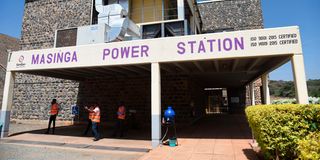Rains boost hydropower production 23pc in April

Masinga Power Station at Masinga Dam in Machakos County.
What you need to know:
- Kenya received heavy rains starting in March before subsiding earlier this month.
- While the rains caused havoc, they also filled major dams across the country.
The generation of hydropower, one of the cheapest sources of power, increased by 23.2 pe rcent in April due to the heavy rains across the country during the month.
According to data from the Energy and Petroleum Regulatory Authority (Epra), the 13 major hydropower plants generated 358 million kilowatt-hours (kWh) during the month.
This was a significant jump from 290.48 million units in the previous month, and the highest in nearly three years since a high of 369.02 million units in May 2021.
“Total units purchased from hydropower plants with a capacity equal to or above one megawatt equalled 358,027,261 kWh,” said Epra director-general Daniel Kiptoo in a gazette notice.
Hydro is one of Kenya’s power sources, alongside geothermal, wind, solar, and thermal sources.
It is also the cheapest, which means that when more hydropower is fed to the national grid, it displaces expensive sources such as thermal, leading to lower charges.
Kenya received heavy rains starting in March before subsiding earlier this month.
While the rains caused havoc, including the deaths of 291 individuals and, the destruction of property and infrastructure such as roads and bridges, they also filled major dams across the country.
Kenya Electricity Generating Company (KenGen), the leading power producer, said water flow hit 850 metres per second at the beginning of the month.
The huge volume of water saw Masinga, Kenya’s largest power-generating dam, hit 1,058.22 metres above sea level, the highest on record.
“Going forward KenGen with the support of the government is considering raising Masinga Dam by 1.5 metres, which will help hold more water and further delay the overflow of the dam during heavy rains,” said the company.
The cheaper hydropower, in addition to the strengthening of the shilling against the US dollar in recent months, has helped lower the cost of power, handing relief to consumers.
In May’s power prices review, for instance, the Epra cut power prices by 73 cents per unit, marking the fourth consecutive decrease in power prices.
As a result, an ordinary domestic customer will be paying about Sh1,277, for 50 units of power this month, a marginal drop from Sh1,311 last month.
At the same time, those who use 100 units will pay Sh2,554 compared to Sh2,623 in April while for 200 units, customers will pay Sh5,109 down from Sh5,245 last month.





